语法及练习3 名词复数和动词三单
常用动词三单名词复数
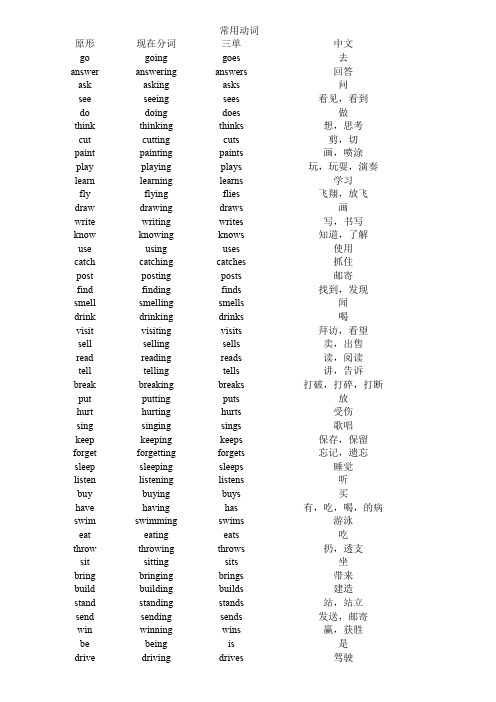
常用动词原形现在分词三单中文go going goes 去answer answering answers 回答ask asking asks 问see seeing sees 看见,看到do doing does 做think thinking thinks 想,思考cut cutting cuts 剪,切paint painting paints 画,喷涂play playing plays 玩,玩耍,演奏learn learning learns 学习fly flying flies 飞翔,放飞draw drawing draws 画write writing writes 写,书写know knowing knows 知道,了解use using uses 使用catch catching catches 抓住post posting posts 邮寄find finding finds 找到,发现smell smelling smells 闻drink drinking drinks 喝visit visiting visits 拜访,看望sell selling sells 卖,出售read reading reads 读,阅读tell telling tells 讲,告诉break breaking breaks 打破,打碎,打断put putting puts 放hurt hurting hurts 受伤sing singing sings 歌唱keep keeping keeps 保存,保留forget forgetting forgets 忘记,遗忘sleep sleeping sleeps 睡觉listen listening listens 听buy buying buys 买have having has 有,吃,喝,的病swim swimming swims 游泳eat eating eats 吃throw throwing throws 扔,透支sit sitting sits 坐bring bringing brings 带来build building builds 建造stand standing stands 站,站立send sending sends 发送,邮寄win winning wins 赢,获胜be being is 是drive driving drives 驾驶※附一:动词三单★一般现在时:表示经常性的事情。
单数名词变复数的规则以及动词第三人称单数形式变化规则
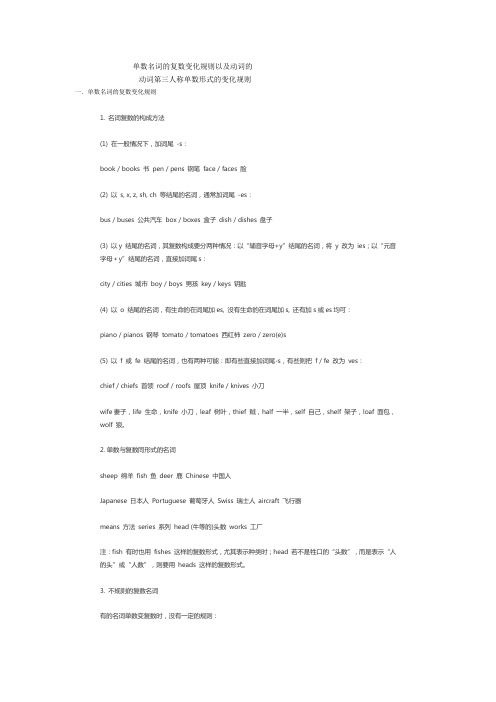
单数名词的复数变化规则以及动词的动词第三人称单数形式的变化规则一.单数名词的复数变化规则1. 名词复数的构成方法(1) 在一般情况下,加词尾-s:book / books 书pen / pens 钢笔face / faces 脸(2) 以s, x, z, sh, ch 等结尾的名词,通常加词尾-es:bus / buses 公共汽车box / boxes 盒子dish / dishes 盘子(3) 以y 结尾的名词,其复数构成要分两种情况:以“辅音字母+y”结尾的名词,将y 改为ies;以“元音字母+y”结尾的名词,直接加词尾s:city / cities 城市boy / boys 男孩key / keys 钥匙(4) 以o 结尾的名词,有生命的在词尾加es, 没有生命的在词尾加s, 还有加s或es均可:piano / pianos 钢琴tomato / tomatoes 西红柿zero / zero(e)s(5) 以f 或fe 结尾的名词,也有两种可能:即有些直接加词尾-s,有些则把f / fe 改为ves:chief / chiefs 首领roof / roofs 屋顶knife / knives 小刀wife妻子,life 生命,knife 小刀,leaf 树叶,thief 贼,half 一半,self 自己,shelf 架子,loaf 面包,wolf 狼。
2.单数与复数同形式的名词sheep 绵羊fish 鱼deer 鹿Chinese 中国人Japanese 日本人Portuguese 葡萄牙人Swiss 瑞士人aircraft 飞行器means 方法series 系列head (牛等的)头数works 工厂注:fish 有时也用fishes 这样的复数形式,尤其表示种类时;head 若不是牲口的“头数”,而是表示“人的头”或“人数”,则要用heads 这样的复数形式。
3. 不规则的复数名词有的名词单数变复数时,没有一定的规则:man / men 男人woman / women 女人child / children 小孩tooth / teeth 牙齿foot / feet 脚goose / geese 鹅mouse / mice 老鼠ox / oxen 公牛注:(1) 一些以man, woman 结尾的合成词,在构成复数与man, woman 的变化形式相同,如:policeman/ policemen 警察,gentleman / gentlemen 绅士,Englishman / Englishmen 英国人,等等。
名词单复数动词第三人称单复数练习题
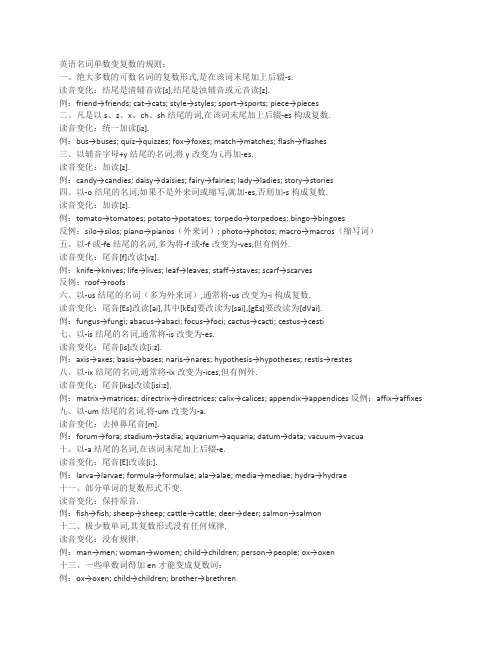
英语名词单数变复数的规则:一、绝大多数的可数名词的复数形式,是在该词末尾加上后辍-s.读音变化:结尾是清辅音读[s],结尾是浊辅音或元音读[z].例:friend→friends; cat→cats; style→styles; sport→sports; piece→pieces二、凡是以s、z、x、ch、sh结尾的词,在该词末尾加上后辍-es构成复数.读音变化:统一加读[iz].例:bus→buses; quiz→quizzes; fox→foxes; match→matches; flash→flashes三、以辅音字母+y结尾的名词,将y改变为i,再加-es.读音变化:加读[z].例:candy→candies; daisy→daisies; fairy→fairies; lady→ladies; story→stories四、以-o结尾的名词,如果不是外来词或缩写,就加-es,否则加-s构成复数.读音变化:加读[z].例:tomato→tomatoes; potato→potatoes; torpedo→torpedoes; bingo→bingoes反例:silo→silos; piano→pianos(外来词); photo→photos; macro→macros(缩写词)五、以-f或-fe结尾的名词,多为将-f或-fe改变为-ves,但有例外.读音变化:尾音[f]改读[vz].例:knife→knives; life→lives; leaf→leaves; staff→staves; scarf→scarves反例:roof→roofs六、以-us结尾的名词(多为外来词),通常将-us改变为-i构成复数.读音变化:尾音[Es]改读[ai],其中[kEs]要改读为[sai],[gEs]要改读为[dVai].例:fungus→fungi; abacus→abaci; focus→foci; cactus→cacti; cestus→cesti七、以-is结尾的名词,通常将-is改变为-es.读音变化:尾音[is]改读[i:z].例:axis→axes; basis→bases; naris→nares; hypothesis→hypotheses; restis→restes八、以-ix结尾的名词,通常将-ix改变为-ices,但有例外.读音变化:尾音[iks]改读[isi:z].例:matrix→matrices; directrix→directrices; calix→calices; appendix→appendices反例:affix→affixes 九、以-um结尾的名词,将-um改变为-a.读音变化:去掉鼻尾音[m].例:forum→fora; stadium→stadia; aquarium→aquaria; datum→data; vacuum→vacua十、以-a结尾的名词,在该词末尾加上后辍-e.读音变化:尾音[E]改读[i:].例:larva→larvae; formula→formulae; ala→alae; media→mediae; hydra→hydrae十一、部分单词的复数形式不变.读音变化:保持原音.例:fish→fish; sheep→sheep; cattle→cattle; deer→deer; salmon→salmon十二、极少数单词,其复数形式没有任何规律.读音变化:没有规律.例:man→men; woman→women; child→children; person→people; ox→oxen十三、一些单数词得加en才能变成复数词:例:ox→oxen; child→children; brother→brethren十四、一些单数词得改头换面一番,才能变成复数词例:analysis→analyses分析; basis→bases基础; datum→data数据; foot→feet;formula→formulae/formulas公式; goose→geese; louse→lice虱子; man→menmouse→mice; medium→media/mediums媒介; memorandum→memoranda/memorandums备忘录; parenthesis→parentheses圆括号; phenomenon→phenomena现象; radius→radii半径tooth→teeth; woman→women十五、有些名词是单数、复数不分的例:deer; fish; cannon; sheep; salmon 鲑鱼; trout 鳟鱼十六、一些名词虽分单数、复数,但出现次数多的总是单数词例:abscence; clothing; film; help; furniture家具; machinery机械; news; scenery风景; sugar;traffic交通十七、另一些名词则以复数词出现的机会较多例:bellows风箱; clothes; police; shorts短裤; scissors剪刀; spectacles眼镜; shears大剪刀trousers长裤; wages工资十八、compound nouns,这类复数词是以主要的名词来表示例:daughter-in-law→daughters-in-law媳妇; father-in-law→fathers-in-law岳父man-of-war→men-of-war兵舰; maid-servant→maid-servantsstep-son→step-sons晚子; son-in-law→sons-in-law十九、若表达具体数目,要借助数量词例:pair(对,双); suit(套); a pair of glasses; two pairs of trousers二十、另外还有一些名词,其复数形式有时可表示特别意思,例:goods货物,waters水域,fishes(各种)鱼二十一、除人民币元、角、分外,美元、英镑、法郎等都有复数形式.例:adollar,two dollars; a meter,two meters第三人称单数第三人称单数是英语中的一种语法,也称“三单”或“单三”,用于一般现在时的句子,当动词在第三人称单数后时【she、he 、it、不可数名词和人名(一个人的)】,要根据其情况变化。
英语动词单三变化规则及名词单数变复数口诀

英语动词第三人称单数变化规则及名词单数变复数口诀一、动词的第三人称单数现在式变化规则:1)一般由动词原形加-sget-gets play-plays2)以e结尾的动词,加-slike-likes make-makes3)以o结尾的动词加-esgo-goes do-does4)以s, x, ch, sh等字母结尾的动词,后面加-eskiss-kisses fix-fixes teach-teaches fish-fishes 5)以辅音字母加y结尾的动词,先将y变i, 再加-esfly-flies study-studies6) have –has1、一般现在时①主语+动词原型VI have a friend. You have a friend. We have a friend.They have a friend.②主语(第三人称单数)+动词V(三单)She / He / It has a friend.Tom / My mother has a friend.2.不规则动词过去式与过去分词分类记忆表(一)、AAA. (原形,过去式和过去分词一致)1. 花费 cost cost cost2. 割 cut cut cut3. 伤害 hurt hurt hurt4. 让 let let let5. 放 put put put6. 朗读 read read read7. 设置 set set set 8.打击,碰撞 hit hit hit9.关上门窗 shut shut shut 10.让 let let let(二)、ABB(过去式和过去分词一致)1) 过去式、过去分词含有-ought1. 带来 bring brought brought2. 买 buy bought bought3. 打架 fight fought fought4. 想 think thought thought5. 寻找、探究 seek sought sought2) 过去式、过去分词含有-aught5. 抓住 catch caught caught6. 教 teach taught taughtt替换原形-d3) 过去式、过去分词-7. 建筑 build built built 8. 借出 lend lent lent9. 花费 spend spent spent 10.派遣 send sent sent 4) 过去式、过去分词在原形词尾加t或d11. 学会 learn learnt/ed learnt/ed 12. 意思 mean meant meant13. 燃烧 burn burnt/ed burnted 13. 做梦 dream dreamt/ed dreamt/ed 13. 处理 deal dealt dealt14. 听 hear heard heard5) 过去式、过去分词改为-ept15. 保持 keep kept kept 16. 睡觉 sleep slept slept17. 扫 sweep swept swept6) 过去式、过去分词改为-elt18. 感觉 feel felt fel 19. 嗅 smell smelt/ed smelt/ed 20. 拼写 spell spelt/ed spelt/ed 7) 过去式、过去分词改为-aid20. 孵蛋 lay laid laid 21. 说 say said said 22. 支付 pay paid paid8) 过去式、过去分词改为-old23. 卖 sell sold sold24. 告诉 tell told told9) 过去式、过去分词改为-ood25 站 stand stood stood26.明白 understand understood understood10) 其它变化27.得到 get got got(gotten) 28.坐 sit sat sat29.照顾 babysit babysat babysat 30.离开 leave left left31.失去 lose lost lost 32.找到 find found found33.有 have(has) had had 34.握住,召开 hold held held35.制造 make made made 36.悬挂 hang hung hung37.照耀 shine shone shone 39.赢 win won won40逃跑 flee fled fled 41喂feed fed fed42.引导,导致 lead led led 43遇见 meet met met三、ABA (过去式与原形一致)1.变成 become became become2. 来 come came come3. 跑 run ran run 四、ABC (原形、过去式、过去分词各不一样)1). 过去分词在过去式或原形后加-n或-en1. 击败 beat beat beaten2. 破坏 break broke broken3. 驾驶 drive drove driven4. 吃 eat ate eaten5. 落下 fall fell fallen6. 给 give gave given7. 生长 grow grew grown8. 知道 know knew known9. blow blew blown10. 扔 throw threw thrown11. 展示 show showed shown12.弄错,错误 mistake mistook mistaken 13. 拿 take took taken14.摇动 shake shook shaken 15. 说 speak spoke spoken16. 选择 choose chose chosen2) 三种形式都有变化1. 是 be( is, am, are ) was/were been2. 开始 begin began begun3. 做 do did done4. 喝 drink drank drunk5. 飞fly flew flown6. 忘记 forget forgot forgotten(forgot)7. 躺 lie lay lain8. 骑 ride rode ridden 9. 打电话 ring rang rung10. 唱 sing sang sung 11. 穿 wear wore worn 12. 游泳 swim swam swum 13. 写 write wrote written 14. 去 go went gone语法(Grammar)一、现在完成时的构成现在完成时的构成:助动词 have (has)+动词的过去分词过去分词的构成方法如下 : A:1.一般情况下,直接在动词原形后面加–ed. worked answered obeyed wanted 2.以不发音的 -e 结尾的动词只加–d. moved hoped divided3.字尾是辅音+y的动词。
名词变复数及动词第三人称单数

名词变复数及动词第三人称单数知识汇总一、变形规则1、词尾直接加s(多数为这种)○1可数名词变复数Students→studentsapples→applesbags→bagstree→treesbook→booksbrother→brothers○2动词变第三人称单数work→workslive→livesmake→makesclose→closes2、以s、x、sh、ch结尾的名词加es○1可数名词变复数glass→glassesbox→boxesbrush→brushesmatch→matches○2动词变第三人称单数miss→missesfix→fixesfinish→finishesteach→teaches3、以辅音字母加y结尾的名词,变y为i加es○1可数名词变复数city→citiesbaby→babies○2动词变第三人称单数fly→flies4、以辅音字母加o结尾的单词,加es(仅限动词第三人称单数形式)go→goesdo→does以下为名词变复数专用,动词变第三人称单词仅以上4种5、以f或fe结尾的名词,多数变f或fe为ves(例外情况是roof的复数形式为roofs)wife→wivesknife→knivesthief→thievslife→liveshalf→halvesleaf→leavesshelf→shelveswolf→wolves6、以o结尾的名词,一般直接加s,5个例外情况要记熟(加es)radio→radioszoo→zoospiano→pianosphoto→photos以下5个例外情况要记熟(黑人英雄爱吃土豆、西红柿和芒果)negro→negroeshero→heroespotato→potatoestomato→tomatoesmango→mangoes7、不规则变化(用口诀记):oo常常变eefoot→ feet goose→ geese tooth→ teeth男人、女人总把a来变成eman→ men woman→ women孩子老鼠不听话child→ childrenmouse→ mice羊鹿中日无变化sheep→ sheep deer→ deerChinese→ChineseJapanese→Japanese。
3名词复数和动词第三人称单数及练习(五篇材料)
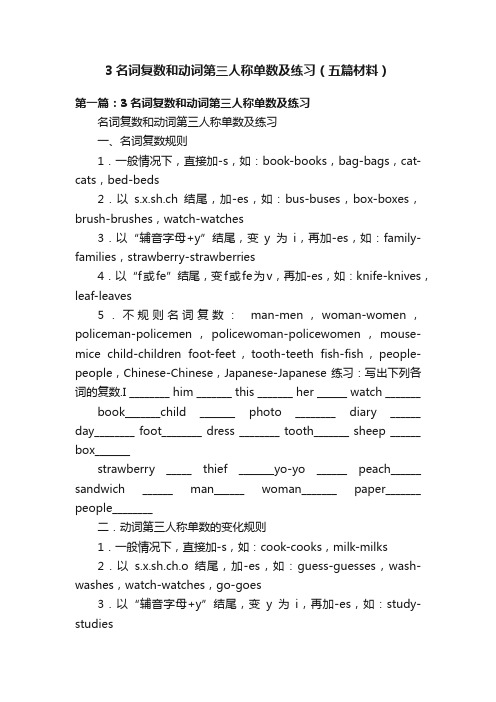
3名词复数和动词第三人称单数及练习(五篇材料)第一篇:3 名词复数和动词第三人称单数及练习名词复数和动词第三人称单数及练习一、名词复数规则1.一般情况下,直接加-s,如:book-books,bag-bags,cat-cats,bed-beds2.以s.x.sh.ch结尾,加-es,如:bus-buses,box-boxes,brush-brushes,watch-watches3.以“辅音字母+y”结尾,变y为i,再加-es,如:family-families,strawberry-strawberries4.以“f或fe”结尾,变f或fe为v,再加-es,如:knife-knives,leaf-leaves5.不规则名词复数:man-men,woman-women,policeman-policemen,policewoman-policewomen,mouse-mice child-children foot-feet,tooth-teeth fish-fish,people-people,Chinese-Chinese,Japanese-Japanese 练习:写出下列各词的复数.I ________ him _______ this _______ her ______ watch _______ book_______child _______ photo ________ diary ______ day________ foot________ dress ________ tooth_______ sheep ______ box_______strawberry _____ thief _______yo-yo ______ peach______ sandwich ______ man______ woman_______ paper_______ people________二.动词第三人称单数的变化规则1.一般情况下,直接加-s,如:cook-cooks,milk-milks2.以s.x.sh.ch.o结尾,加-es,如:guess-guesses,wash-washes,watch-watches,go-goes3.以“辅音字母+y”结尾,变y为i,再加-es,如:study-studies练习:写出下列动词的第三人称单数.drink _______ go ______ stay ________ make _______ look_______have_______ pass_______ carry ____ come________ watch______plant_______ fly ________ study_______ brush________ teach_______第二篇:第三人称名词单数变复数动词原形变第三人称单数的规则与发音规律同名词单数变复数大致相同,请认真观察。
名词变复数、动词三单、动名词

will have、will be等。
03
动名词
动名词的构成方式
1 2
动词原形+ing
大多数动名词是由动词原形+ing构成,例如 “reading”(阅读)。
少数动词以“-ing”结尾
有些动词的动名词形式直接以“-ing”结尾,例 如“going”(去)。
3
特殊变化的动词
有些动词的动名词形式需要进行特殊变化,例如 “running”(跑)。
02
03
作为介词宾语
动名词可以作为介词宾语,例如 “I am interested in reading books”(我对读书很感兴趣)。
04
感谢您的观看
THANKS
04
不规则变化
01
有些名词的复数形式是不规则的, 需要单独记忆。例如: child→children,ox→oxen。
02
还有一些特殊的复数形式,如: man→men,woman→women, tooth→teeth等。
复合名词的复数形式
复合名词的复数形式通常是将复合名 词中的每个单词都变成复数形式。例 如:boyfriend→boyfriends。
Байду номын сангаас
动名词的时态和语态变化
时态变化
动名词可以表达过去、现在和未来 的时间,例如“running”(跑步) 可以表示现在进行时或过去进行时。
语态变化
动名词没有被动语态,但有时可以 用主动语态表示被动意义,例如 “cleaning the room”(打扫房 间)可以表示房间被打扫。
动名词的用法
作为宾语
在此添加您的文本16字
特殊动词如be动词(is)、have(has)等不规则变化。
名词复数_动词三单_现在分词_过去式变化规则
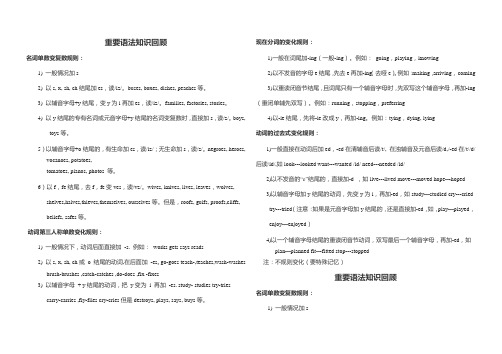
重要语法知识回顾名词单数变复数规则:1) 一般情况加s2) 以s, x, sh, ch结尾加es,读/iz/。
buses, boxes, dishes, peaches等。
3) 以辅音字母+y结尾,变y为i再加es,读/iz/。
families, factories, stories。
4) 以y结尾的专有名词或元音字母+y结尾的名词变复数时,直接加s,读/z/。
boys,toys等。
5)以辅音字母+o结尾的,有生命加es,读/iz/;无生命加s,读/z/。
negroes, heroes, vocanoes, potatoes,tomatoes, pianos, photos 等。
6)以f,fe结尾,去f,fe变ves,读/vz/。
wives, knives, lives, leaves,wolves, shelves,halves,thieves,themselves, ourselves等。
但是,roofs, gulfs, proofs,cliffs,beliefs, safes等。
动词第三人称单数变化规则:1) 一般情况下,动词后面直接加-s. 例如:works gets says reads2) 以s, x, sh, ch或o 结尾的动词,在后面加-es。
go-goes teach-,teaches,wash-washesbrush-brushes ,catch-catches ,do-does ,fix -fixes3) 以辅音字母+ y结尾的动词,把y变为i 再加-es. study- studies try-triescarry-carries ,fly-flies cry-cries但是destroys, plays, says, buys等。
现在分词的变化规则:1)一般在词尾加-ing(一般-ing)。
例如:going,playing,knowing2)以不发音的字母e结尾,先去e再加-ing(去哑e)。
人教上语法名词单复数语法及练习

名词单复数名词:包括可数名词(如:pear ,tomato ,banana, carrot )和不可数名词(如:drink, beef, chicken, meat, coffee)修饰词: 做主语时:名词复数做主语时:可数名词单数变复数规则:1.a;an(名词首字母发音为元音),one 都表示一个 2.this(这个); that(那个) ;the (表示特定的某一个) 3.my,your 等形容性物主代词 可数名词单可数名词复数可数名词练习题:1.I want to buy some____________(tomato).2.There are two____________(potato)on the table.3.Eating too many______________(vegetable) is good for us.4.Milk and fish are good for your__________(tooth).6.The rabbit love to eat___________(胡萝卜)7.Please give me a kilo of__________(牛肉)8.There is __________(一个) onion in the bag.9.Don’t eat too much_________(盐).10.Too much____________(糖)isn’t good for your health.11.I like to eat________(fish).12.There are some________(fish)in the river .【答案】1.tomatoes 2.potatoes 3.vegetables 4.teeth 5.are6.carrots7.beef8. an9. salt 10. sugar 11. fish12. fishes 13. C知识点二:不可数名词修饰词 不可数名词做主语时too much:太多,后加不可数名词;too many: 太多,后加可数名词复数much too:太,表程度 some 和any 都可以修饰可数名词复数和不可数名词。
常用动词三单、名词复数
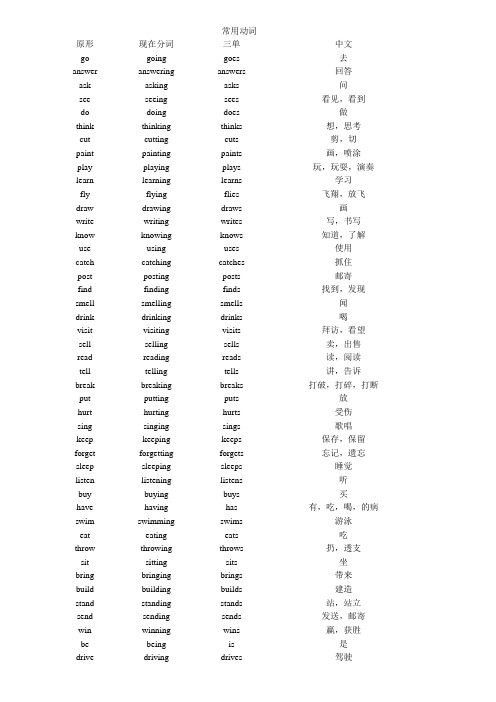
常用动词原形现在分词三单中文go going goes去answer answering answers回答ask asking asks问see seeing sees看见,看到do doing does做think thinking thinks想,思考cut cutting cuts剪,切paint painting paints画,喷涂play playing plays玩,玩耍,演奏learn learning learns学习fly flying flies飞翔,放飞draw drawing draws画write writing writes写,书写know knowing knows知道,了解use using uses使用catch catching catches抓住post posting posts邮寄find finding finds找到,发现smell smelling smells闻drink drinking drinks喝visit visiting visits拜访,看望sell selling sells卖,出售read reading reads读,阅读tell telling tells讲,告诉break breaking breaks打破,打碎,打断put putting puts放hurt hurting hurts受伤sing singing sings歌唱keep keeping keeps保存,保留forget forgetting forgets忘记,遗忘sleep sleeping sleeps睡觉listen listening listens听buy buying buys买have having has有,吃,喝,的病swim swimming swims游泳eat eating eats吃throw throwing throws扔,透支sit sitting sits坐bring bringing brings带来build building builds建造stand standing stands站,站立send sending sends发送,邮寄win winning wins赢,获胜be being is是drive driving drives驾驶常用名词单数复数中文answer answers答案apple apples苹果banana bananas香蕉bed beds床book books书,本box boxes箱子,盒子cake cakes蛋糕car cars汽车card cards卡片cat cats猫chicken chickens小鸡computer computers计算机,电脑cup cups杯子,茶杯dog dogs狗door doors门egg eggs鸡蛋factory factories工厂fish fish鱼foot feet脚fridge fridges冰箱gate gates大门ice-cream ice-creams冰激凌keyboard keyboards键盘knife knives小刀leaf leaves叶子library libraries图书馆mouse mousses老鼠,鼠标panda pandas熊猫pear pears梨person people人pig pigs猪potato potatoes番茄,西红柿question questions问题sheep sheep绵羊shelf shelves架子station stations站,所television televisions电视机thief thieves小偷,贼tomato tomatoes土豆,马铃薯tooth teeth牙,牙齿umbrella umbrellas雨伞video videos录像带wife wives妻子wolf wolves狼★一般现在时:表示经常性的事情。
牛津小学英语3A-6B语法点汇总+练习(讲解相当详细)

语法及练习1 be动词Be 动词的用法:(1) Am--was Is --was Are--were 口诀:我用am, 你用are, is用在他她它,复数全用are。
(2) 肯定和否定句I am (not) from London. He is(not) a teacher. She is(not) in the dining room. My hair is(not) long. Her eyes are(not) small.(3) 一般疑问句Am I a Chinese? Yes, you are. No, you aren’t. Are they American? Yes, they are. No, they aren’t. Is the cat fat? Yes, it is. No, it isn’t.用恰当的be动词填空。
1. I ______ a boy. ______ you a boy? No, I _____ not.2. The girl______ Jack's sister.3. The dog _______ tall and fat.4. The man with big eyes _______ a teacher.5. ______ your brother in the classroom?6. Where _____ your mother? She ______ at home.7. How _______ your father?8. Mike and Liu Tao ______ at school.9. Whose dress ______ this?10. Whose socks ______ they?11. That ______ my red skirt.12. Who ______ I?13.The jeans ______ on the desk.14. Here ______ a scarf for you.15. Here ______ some sweaters for you.16. The black gloves ______ for Su Yang.17. This pair of gloves ______ for Yang Ling.18. The two cups of milk _____ for me.19. Some tea ______ in the glass.20. Gao shan's shirt _______ over there.21. My sister's name ______Nancy.22. This ______ not Wang Fang's pencil.23. ______ David and Helen from England?24. There ______ a girl in the room.25. There ______ some apples on the tree.26. _______ there any kites in the classroom?27. _______ there any apple juice in the bottle?28. There _______ some bread on the plate.29. There _______ a boy, two girls, three men and ten women in the park.30. You, he and I ______ from China.语法及练习2 人称代词和物主代词人称代词和物主代词1.人称代词主格和宾格的区别:主格通常位于句中第一个动词之前(有时候位于than 之后),宾格一般位于动词或介词之后。
三单及名词单复数练习
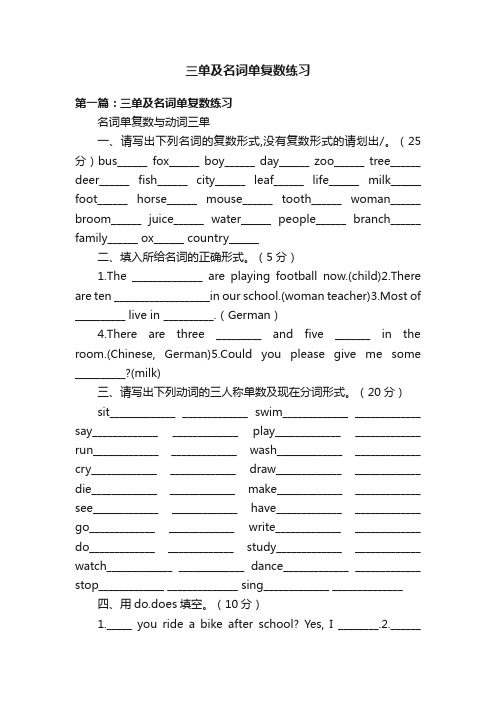
三单及名词单复数练习第一篇:三单及名词单复数练习名词单复数与动词三单一、请写出下列名词的复数形式,没有复数形式的请划出/。
(25分)bus______ fox______ boy______ day______ zoo______ tree______ deer______ fish______ city______ leaf______ life______ milk______ foot______ horse______ mouse______ tooth______ woman______ broom______ juice______ water______ people______ branch______ family______ ox______ country______二、填入所给名词的正确形式。
(5分)1.The ______________ are playing football now.(child)2.There are ten ___________________in our school.(woman teacher)3.Most of __________ live in __________.(German)4.There are three _________ and five _______ in the room.(Chinese, German)5.Could you please give me some __________?(milk)三、请写出下列动词的三人称单数及现在分词形式。
(20分)sit_____________ _____________ swim_____________ _____________ say_____________ _____________ play_____________ _____________ run_____________ _____________ wash_____________ _____________ cry_____________ _____________ draw_____________ _____________ die_____________ _____________ make_____________ _____________ see_____________ _____________ have_____________ _____________ go_____________ _____________ write_____________ _____________ do_____________ _____________ study_____________ _____________ watch_____________ _____________ dance_____________ _____________ stop_____________ ______________ sing_____________ ______________四、用do.does填空。
名词变复数、动词三单形式现在分词过去分词过去式变化及形容词副词级别变化

名词变复数名词变复数的规则变化1.一般名词复数是在名词后面加上“s”,如map→maps,bag→bags等;2.以s,sh,ch,x等结尾的词加“es”,如bus→buses,watch→watches等;3.以辅音字母+y结尾的词,变y为“i”加“es”,如baby→babies等;以元音字母+y结尾的名词变复数时,直接加“s”变复数,如monkey→monkeys,holiday→holidays;4.以o 结尾的名词变复数时:a)无生命的加“s”,名词有:photo→photos,piano→pianos,radio→radios,zoo→zoos b)有生命的加“es”,名词有:potato→potatoes,tomato→tomatoes;5.以f或fe结尾的名词变复数时:a)加“s”的名词有:belief→beliefs,roof→roofs,safe→safes,gulf→gulfsb)去掉f,fe加“ves”的名词有:half→halves knife→knives,leaf→leaves,wolf→wolves,wife→wives,life→lives,thief→thieves;名词变复数的不规则变化1)child→children,foot→feet,tooth→teeth,mouse→mice,man→men,woman→women (注意:由一个词加man 或woman构成的合成词,其复数形式也是-men和-women,如an Englishman,two Englishmen。
但German不是合成词,故复数形式为Germans;Bowman是姓,其复数是the Bowmans。
).2)单复同形,如:deer,sheep,fish,Chinese,Japanese.3)集体名词,以单数形式出现,但实为复数。
例如:people,police,cattle等本身就是复数,不能说a people,a police,a cattle,但可以说a person,a policeman,a herd of cattle. 4)以s结尾,仍为单数的名词,如:A. maths,politics,physics等学科名词,一般是不可数名词,为单数。
小升初小学英语总复习:名词复数变化规则与动词三单变化规则

名词复数规则变化
NO.3 以元音字母+y结尾的词,
直接加s
a boy
1 1 boys
a monkey 2 2 monkeys
名词复数规则变化
NO.4 以辅音字母+y结尾的词,
变y为 i 加es
a lady
1 1 ladies
a baby
2 2 babies
名词复数规则变化
写出下列单词的复数形式。 (1)family__________ (2)orange__________ (3)toy __________ (4)brush__________ (5)bus__________ (6)library__________ (7)peach__________ (8)shoe__________
Part 4
综合练习
一、用括号内动词的适当形式填空。 1. He often ________(have) dinner at home. 2. Daniel and Tommy _____(be) in Class One. 3. We __________ (not watch) TV on Monday. 4. Nick _________ (not go) to the zoo on Sunday. 5. ______ they ________(like) the World Cup?
_____________________________________________
1. Whose book __is___ (be)this? 2.They __have___ (have)a TV. 3.Helen__has____ (have)a toy bear.
动词三单变化规则
英语中名词变复数与动词第三人称单数
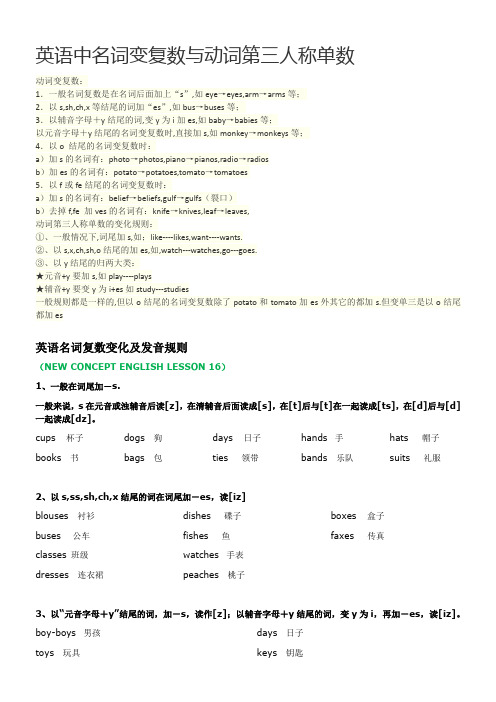
英语中名词变复数与动词第三人称单数动词变复数:1.一般名词复数是在名词后面加上“s”,如eye→eyes,arm→arms等;2.以s,sh,ch,x等结尾的词加“es”,如bus→buses等;3.以辅音字母+y结尾的词,变y为i加es,如baby→babies等;以元音字母+y结尾的名词变复数时,直接加s,如monkey→monkeys等;4.以o 结尾的名词变复数时:a)加s的名词有:photo→photos,piano→pianos,radio→radiosb)加es的名词有:potato→potatoes,tomato→tomatoes5.以f或fe结尾的名词变复数时:a)加s的名词有:belief→beliefs,gulf→gulfs(裂口)b)去掉f,fe 加ves的名词有:knife→knives,leaf→leaves,动词第三人称单数的变化规则:①、一般情况下,词尾加s,如;like----likes,want----wants.②、以s,x,ch,sh,o结尾的加es,如,watch---watches,go---goes.③、以y结尾的归两大类:★元音+y要加s,如play----plays★辅音+y要变y为i+es如study---studies一般规则都是一样的,但以o结尾的名词变复数除了potato和tomato加es外其它的都加s.但变单三是以o结尾都加es英语名词复数变化及发音规则(NEW CONCEPT ENGLISH LESSON 16)1、一般在词尾加-s.一般来说,s在元音或浊辅音后读[z],在清辅音后面读成[s],在[t]后与[t]在一起读成[ts],在[d]后与[d]一起读成[dz]。
cups 杯子books 书dogs 狗bags 包days 日子ties 领带hands 手bands 乐队hats 帽子suits 礼服2、以s,ss,sh,ch,x结尾的词在词尾加-es,读[iz]blouses 衬衫buses 公车classes 班级dresses 连衣裙dishes 碟子fishes 鱼watches 手表peaches 桃子boxes 盒子faxes 传真3、以“元音字母+y”结尾的词,加-s,读作[z];以辅音字母+y结尾的词,变y为i,再加-es,读[iz]。
名词复数和动词三单练习(20210118183840)
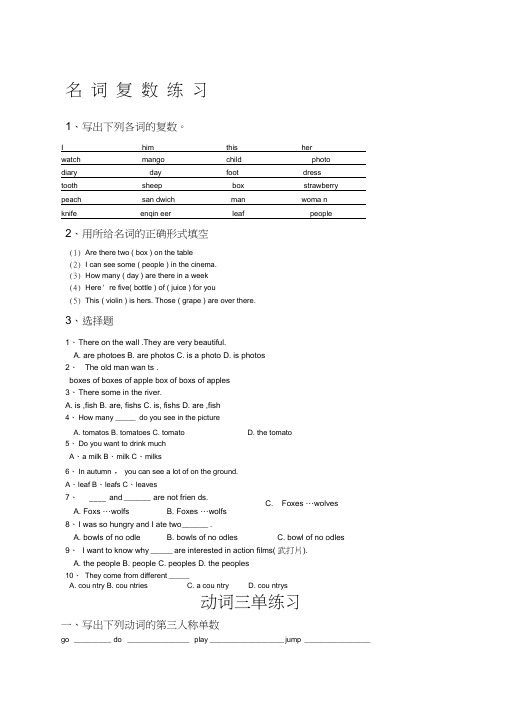
名 词 复 数 练 习1、写出下列各词的复数。
2、用所给名词的正确形式填空(1) Are there two ( box ) on the table(2) I can see some ( people ) in the cinema. (3) How many ( day ) are there in a week (4) Here ' re five( bottle ) of ( juice ) for you(5) This ( violin ) is hers. Those ( grape ) are over there.3、选择题1、 T here on the wall .They are very beautiful.A. are photoesB. are photosC. is a photoD. is photos 2、 The old man wan ts .boxes of boxes of apple box of boxs of apples 3、 T here some in the river.A. is ,fishB. are, fishsC. is, fishsD. are ,fish 4、 How many _____ do you see in the pictureA. tomatosB. tomatoesC. tomato 5、 Do you want to drink much A 、a milk B 、milk C 、milks6、 In autumn , you can see a lot of on the ground. A 、leaf B 、leafs C 、leaves7、 ____ and ______ are not frien ds. A. Foxs …wolfs B. Foxes …wolfs 8、 I was so hungry and I ate two ______ .A. bowls of no odleB. bowls of no odlesC. bowl of no odles9、 I want to know why _____ are interested in action films( 武打片). A. the people B. people C. peoples D. the peoples 10、 They come from different _____动词三单练习一、写出下列动词的第三人称单数go _________ do _______________ play __________________ jump ________________D. the tomatoC. Foxes …wolvesA. cou ntryB. cou ntriesC. a cou ntryD. cou ntrysswim run put si ngdance come get havefly study read lookwalk eat like draw二、用所给词的适当形式填空:1. She (do) homework by herself.2. Jack (go) home by bike.3. The gia(climb) up the bea nstalk. 4 .Her mum (ru n) to the goose. nt5. He (do no t)like apple. 6, Sam (put) it un der his arm.7. The boy (chase) it. 8. Kitty (watch)TV everyday. 9. He (feed)them at 8:00 in the morning. 10. When (do)he get up11. Gra ndma Wang (live) in Pudo ng. 12. The girls (give) the key to Grandpa.13. That k ey ______ (open) the old box. _____ (say) "I like these puppets (do)Alice find三、选择题1. Ben ___ a new book.2. Superdog ______ the boys3. He __ the bea ns in the grou nd.4. Sam ' s bicycle _____ a bell.B has hav ing5. I _____ every day6. He __________ his homework every day.7. I _______ my homework every day.________ t heir homework every day.A. do C. is9. Jack______ their cow.10. Lucy ____ with her han ds.11. Superdog _____ the boys。
名词单复数和动词单三-语法总结-东团的牙整理

名词单数变复数的变化规则ⅰ 规则变化:① 一般名词复数是在名词后面加上“s” a. 清辅音后读/s/ map—mapsb. 浊辅音和元音后读/z/ car—carsbag—bags② 以ce, se, ze, (d)ge等结尾的词,加-s 读/iz/ license-licenses③ 以s, sh, ch, x等结尾的词,加-es 读/iz/ bus-buses watch-watches, box-boxes(注:以o 结尾的名词变复数时:a)加s的有:photo →photos piano →pianos radio →radiosb)加es的有:potato →potatoes tomato →tomatoes④ 以辅音字母+y结尾的词,变y 为i,再加-es 读/z/ baby—babies⑤ 以f或fe结尾的名词变复数时:a)加s的名词有:belief →beliefs roof →roofs safe →safesb)变f为v加es的名词有:thief →thieves half →halvesknife →knives leaf →leaves wolf →wolves life →lives ⅱ 不规则变化:① child—children foot—feet tooth—teeth mouse—mice man—men woman—women★ 注意:与man 和woman构成的合成词,其复数形式也是-men 和-women。
如:an Englishman,two Englishmen. 但German不是合成词,故复数形式为Germans;Bowman是姓,其复数是the Bowmans。
②单复同形如:deer sheep fish Chinese Japanese③集体名词,以单数形式出现,但实为复数。
如:people,police,cattle 等本身就是复数,不能说a people,a police,a cattle,但可以说a person,a policeman,a head of cattle, the English,the British,the French,the Chinese,the Japanese,the Swiss 等名词,表示国民总称时,作复数用。
- 1、下载文档前请自行甄别文档内容的完整性,平台不提供额外的编辑、内容补充、找答案等附加服务。
- 2、"仅部分预览"的文档,不可在线预览部分如存在完整性等问题,可反馈申请退款(可完整预览的文档不适用该条件!)。
- 3、如文档侵犯您的权益,请联系客服反馈,我们会尽快为您处理(人工客服工作时间:9:00-18:30)。
语法及练习3 名词复数和动词三单
一、名词复数规则
1.一般情况下,直接加-s,如:book-books, bag-bags, cat-cats, bed-beds
2.以s. x. sh. ch结尾,加-es,如:bus-buses, box-boxes, brush-brushes, watch-watches
3.以“辅音字母+y”结尾,变y为i, 再加-es,如:family-families, strawberry-strawberries
4.以“f或fe”结尾,变f或fe为v, 再加-es,如:knife-knives 5.不规则名词复数:man-men, woman-women, policeman-policemen, policewoman-policewomen, mouse-mice child-children foot-feet,.tooth-teeth fish-fish, people-people, Chinese-Chinese, Japanese-Japanese
练习:写出下列各词的复数。
I _________ him _________ this _______ her ______ watch _______ book_______
child _______ photo ________ diary ______ day________ foot________ dress ________ tooth_______ sheep ______
box_______ strawberry _____ thief _______yo-yo ______ peach______ sandwich ______ man______ woman_______ paper_______ people________
二.动词三单的变化规则
1.一般情况下,直接加-s,如:cook-cooks, milk-milks 2.以s. x. sh. ch. o结尾,加-es,如:guess-guesses, wash-washes, watch-watches, go-goes
3.以“辅音字母+y”结尾,变y为i, 再加-es,如:study-studies 练习: 写出下列动词的第三人称单数。
drink ________ go _______ stay ________ make
________ look _________
have_______ pass_______ carry ____
come________ watch______
plant_______ fly ________ study_______
brush________ teach_______。
